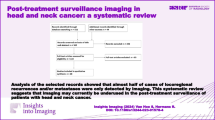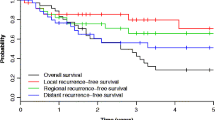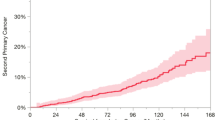Abstract
The management of head and neck squamous cell carcinomas does not end with the completion of ablative therapy. The oncologic objectives of post-treatment follow-up are to detect recurrences and second primary tumors; beyond that, follow-up should evaluate acute and chronic treatment-related side effects, guide the rehabilitation process, alleviate functional loss, manage pain, restore nutritional status and assess psychosocial factors. In this structured review, we address the questions of timing and the tools required to achieve a complete and coherent routine surveillance. Several guidelines and consensus statements recommend clinical examination as the cornerstone of follow-up which should be performed for at least 5 years, although there are no data in favor of any one particular follow-up program, and only low-level evidence suggests an improvement in oncologic outcomes by close follow-up. Baseline imaging (computed tomography and magnetic resonance imaging) should be obtained within 2–6 months after definitive therapy if used for treatment response evaluation. Metabolic response, if indicated, should be assessed preferably after 3 months in patients who undergo curative-intent therapy with (chemo)-radiotherapy. Chest computed tomography is more sensitive than plain radiography, if used in follow-up, but the benefit and cost-effectiveness of routine chest computed tomography has not been demonstrated. There are no current data supporting modifications specific to the surveillance plan of patients with human papillomavirus-associated disease.
Similar content being viewed by others
References
Cooney TR, Poulsen MG (1999) Is routine follow-up useful after combined-modality therapy for advanced head and neck cancer? Arch Otolaryngol Head Neck Surg 125:379–382
Virgo KS, Paniello RC, Johnson FE (1998) Costs of posttreatment surveillance for patients with upper aerodigestive tract cancer. Arch Otolaryngol Head Neck Surg 124:564–572
Boysen M, Lövdal O, Tausjö J, Winther F (1992) The value of follow-up in patients treated for squamous cell carcinoma of the head and neck. Eur J Cancer 28:426–430
de Visscher AV, Manni JJ (1994) Routine long-term follow-up in patients treated with curative intent for squamous cell carcinoma of the larynx, pharynx, and oral cavity. Does it make sense? Arch Otolaryngol Head Neck Surg 120:934–939
Lester SE, Wight RG (2009) ‘When will I see you again?’ Using local recurrence data to develop a regimen for routine surveillance in post-treatment head and neck cancer patients. Clin Otolaryngol 34:546–551
Wensing BM, Merkx MA, Krabbe PF, Marres HA, Van den Hoogen FJ (2011) Oral squamous cell carcinoma and a clinically negative neck: the value of follow-up. Head Neck 33:1400–1405
Ridge JA (1993) Squamous cancer of the head and neck: surgical treatment of local and regional recurrence. Semin Oncol 20:419–429
Haigentz M Jr, Hartl DM, Silver CE et al (2012) Distant metastases from head and neck squamous cell carcinoma. Part III. Treatment. Oral Oncol 48:787–793
Kurzweg T, Möckelmann N, Laban S, Knecht R (2012) Current treatment options for recurrent/metastatic head and neck cancer: a post-ASCO 2011 update and review of last year’s literature. Eur Arch Otorhinolaryngol [Epub ahead of print]
Balermpas P, Keller C, Hambek M et al (2012) Reirradiation with cetuximab in locoregional recurrent and inoperable squamous cell carcinoma of the head and neck: feasibility and first efficacy results. Int J Radiat Oncol Biol Phys 83:e377–e383
Tan IB, Dolivet G, Ceruse P, Vander Poorten V, Roest G, Rauschning W (2010) Temoporfin-mediated photodynamic therapy in patients with advanced, incurable head and neck cancer: a multicenter study. Head Neck 2:1597–1604
Schwartz LH, Ozsahin M, Zhang GN et al (1994) Synchronous and metachronous head and neck carcinomas. Cancer 74:1933–1938
Sturgis EM, Miller RH (1995) Second primary malignancies in the head and neck cancer patient. Ann Otol Rhinol Laryngol 104:946–954
Kaanders JH, Dutch Cooperative Head and Neck Oncology Group (2002) Carcinoma of the larynx: the Dutch national guideline for diagnostics, treatment, supportive care and rehabilitation. Radiother Oncol 63:299–307
Johnson F, Johnson M, Virgo K (1997) Current follow-up strategies after potentially curative resection of upper aerodigestive tract epidermoid carcinoma. Int J Oncol 10:927–931
Paniello RC, Virgo KS, Johnson MH, Clemente MF, Johnson FE (1999) Practice patterns and clinical guidelines for posttreatment follow-up of head and neck cancers: a comparison of 2 professional societies. Arch Otolaryngol Head Neck Surg 125:309–313
Andl T, Kahn T, Pfuhl A et al (1998) Etiological involvement of oncogenic human papillomavirus in tonsillar squamous cell carcinomas lacking retinoblastoma cell cycle control. Cancer Res 58:5–13
Ang KK, Harris J, Wheeler R et al (2010) Human papillomavirus and survival of patients with oropharyngeal cancer. N Engl J Med 363:24–35
Manikantan K, Khode S, Dwivedi RC et al (2009) Making sense of post-treatment surveillance in head and neck cancer: when and what of follow-up. Cancer Treat Rev 35:744–753
Flynn CJ, Khaouam N, Gardner S et al (2010) The value of periodic follow-up in the detection of recurrences after radical treatment in locally advanced head and neck cancer. Clin Oncol (R Coll Radiol) 22:868–873
Merkx MA, van Gulick JJ, Marres HA et al (2006) Effectiveness of routine follow-up of patients treated for T1-2N0 oral squamous cell carcinomas of the floor of mouth and tongue. Head Neck 28:1–7
Ritoe SC, Krabbe PF, Kaanders JH, van den Hoogen FJ, Verbeek AL, Marres HA (2004) Value of routine follow-up for patients cured of laryngeal carcinoma. Cancer 101:1382–1389
Ritoe SC, Verbeek AL, Krabbe PF, Kaanders JH, van den Hoogen FJ, Marres HA (2007) Screening for local and regional cancer recurrence in patients curatively treated for laryngeal cancer: definition of a high-risk group and estimation of the lead time. Head Neck 29:431–438
Kissun D, Magennis P, Lowe D, Brown JS, Vaughan ED, Rogers SN (2006) Timing and presentation of recurrent oral and oropharyngeal squamous cell carcinoma and awareness in the outpatient clinic. Br J Oral Maxillofac Surg 44:371–376
Johnson FE, Johnson MH, Clemente MF, Paniello RC, Virgo KS (2006) Geographical variation in surveillance strategies after curative-intent surgery for upper aerodigestive tract cancer. Ann Surg Oncol 13:1063–1071
Kazi R, Manikanthan K, Pathak KA, Dwivedi RC (2010) Head and neck squamous cell cancers: need for an organised time-bound surveillance plan. Eur Arch Otorhinolaryngol 267:1969–1971
British Association of Head and Neck Oncologists (2001) Practice care guidance for clinicians participating in the management of head and neck cancer patients in the UK. Drawn up by a consensus group of practising clinicians. Practice care guidance for clinicians participating in the management of head and neck cancer patients in the UK. EJSO 27(Suppl A):S1–S17
Pfister DG, Ang KK, Brizel DM et al (2011) National Comprehensive Cancer Network clinical practice guidelines in oncology. Head and neck cancers. J Natl Compr Canc Netw 9:596–650
Johnson FE, Virgo KS, Clemente MF, Johnson MH, Paniello RC (1998) How tumor stage affects surgeons’ surveillance strategies after surgery for carcinoma of the upper aerodigestive tract. Cancer 82:1932–1937
Coca-Pelaz A, Rodrigo JP, Suárez C (2012) Clinicopathologic analysis and predictive factors for distant metastases in patients with head and neck squamous cell carcinomas. Head Neck 34:771–775
de Bree R, Haigentz M Jr, Silver CE et al (2012) Distant metastases from head and neck squamous cell carcinoma. Part II. Diagnosis. Oral Oncol 48:780–786
Daisne JF, Duprez T, Weynand B et al (2004) Tumor volume in pharyngolaryngeal squamous cell carcinoma: comparison at CT, MR imaging, and FDG PET and validation with surgical specimen. Radiology 233:93–100
Manikantan K, Dwivedi RC, Sayed SI, Pathak KA, Kazi R (2011) Current concepts of surveillance and its significance in head and neck cancer. Ann R Coll Surg Engl 93:576–582
Chu PY, Tsai TL, Tai SK, Chang SY (2012) Effectiveness of narrow band imaging in patients with oral squamous cell carcinoma after treatment. Head Neck 34:155–161
Piazza C, Cocco D, De Benedetto L, Bon FD, Nicolai P, Peretti G (2010) Role of narrow-band imaging and high-definition television in the surveillance of head and neck squamous cell cancer after chemo- and/or radiotherapy. Eur Arch Otorhinolaryngol 267:1423–1428
Rydell R, Eker C, Andersson-Engels S, Krogdahl A, Wahlberg P, Svanberg K (2008) Fluorescence investigations to classify malignant laryngeal lesions in vivo. Head Neck 30:419–426
Tschiesner U, Rogers S, Dietz A, Yueh B, Cieza A (2010) Development of ICF core sets for head and neck cancer. Head Neck 32:210–220
Leib A, Cieza A, Tschiesner U (2012) Perspective of physicians within a multidisciplinary team: content validation of the comprehensive ICF core set for head and neck cancer. Head Neck 34:956–966
Schuurhuis JM, Stokman MA, Roodenburg JL et al (2011) Efficacy of routine pre-radiation dental screening and dental follow-up in head and neck oncology patients on intermediate and late radiation effects. A retrospective evaluation. Radiother Oncol 101:403–409
Tolentino Ede S, Centurion BS, Ferreira LH, Souza AP, Damante JH, Rubira-Bullen IR (2011) Oral adverse effects of head and neck radiotherapy: literature review and suggestion of a clinical oral care guideline for irradiated patients. J Appl Oral Sci 19:448–454
Ho KF, Farnell DJ, Routledge JA et al (2009) Developing a CTCAEs patient questionnaire for late toxicity after head and neck radiotherapy. Eur J Cancer 45:1992–1998
Stoeckli SJ, Zimmermann R, Schmid S (2001) Role of routine panendoscopy in cancer of the upper aerodigestive tract. Otolaryngol Head Neck Surg 124:208–212
Rachmat L, Vreeburg GC, de Vries N et al (1993) The value of twice yearly bronchoscopy in the work-up and follow-up of patients with laryngeal cancer. Eur J Cancer 29A:1096–1099
Haughey BH, Gates GA, Arfken CL, Harvey J (1992) Meta-analysis of second malignant tumors in head and neck cancer: the case for an endoscopic screening protocol. Ann Otol Rhinol Laryngol 101:105–112
Lee P, de Bree R, Brokx HA, Leemans CR, Postmus PE, Sutedja TG (2008) Primary lung cancer after treatment of head and neck cancer without lymph node metastasis: is there a role for autofluorescence bronchoscopy? Lung Cancer 62:309–315
Bakhshandeh M, Hashemi B, Mahdavi SR, Nikoofar A, Vasheghani M, Kazemnejad A (2012) Normal tissue complication probability modeling of radiation-induced hypothyroidism after head-and-neck radiation therapy. Int J Radiat Oncol Biol Phys [Epub ahead of print]
Vogelius IR, Bentzen SM, Maraldo MV, Petersen PM, Specht L (2011) Risk factors for radiation-induced hypothyroidism. Cancer 117:5250–5260
Sinard RJ, Tobin EJ, Mazzaferri EL et al (2000) Hypothyroidism after treatment for nonthyroid head and neck cancer. Arch Otolaryngol Head Neck Surg 126:652–657
Jereczek-Fossa BA, Alterio D, Jassem J, Gibelli B, Tradati N, Orecchia R (2004) Radiotherapy-induced thyroid disorders. Cancer Treat Rev 30:369–384
Garcia-Serra A, Amdur RJ, Morris CG, Mazzaferri E, Mendenhall WM (2005) Thyroid function should be monitored following radiotherapy to the low neck. Am J Clin Oncol 28:255–258
Hermans R, Pameijer FA, Mancuso AA, Parsons JT, Mendenhall WM (2000) Laryngeal or hypopharyngeal squamous cell carcinoma: can follow-up CT after definitive radiation therapy be used to detect local failure earlier than clinical examination alone? Radiology 214:683–687
Wang J, Takashima S, Takayama F et al (2001) Head and neck lesions: characterization with diffusion-weighted echo-planar MR imaging. Radiology 220:621–630
Vandecaveye V, De Keyzer F, Nuyts S et al (2007) Detection of head and neck squamous cell carcinoma with diffusion weighted MRI after (chemo)radiotherapy: correlation between radiologic and histopathologic findings. Int J Radiat Oncol Biol Phys 67:960–971
Vandecaveye V, Dirix P, De Keyzer F et al (2012) Diffusion-weighted magnetic resonance imaging early after chemoradiotherapy to monitor treatment response in head-and-neck squamous cell carcinoma. Int J Radiat Oncol Biol Phys 82:1098–1107
León X, Quer M, Orús C, del Prado Venegas M, López M (2000) Distant metastases in head and neck cancer patients who achieved loco-regional control. Head Neck 22:680–686
Ferlito A, Shaha AR, Rinaldo A, Pellitteri PK, Mondin V, Byers RM (2002) “Skip metastases” from head and neck cancers. Acta Otolaryngol 122:788–791
Engelen AM, Stalpers LJ, Manni JJ, Ruijs JH, van Daal WA (1992) Yearly chest radiography in the early detection of lung cancer following laryngeal cancer. Eur Arch Otorhinolaryngol 249:364–369
Warner GC, Cox GJ (2003) Evaluation of chest radiography versus chest computed tomography in screening for pulmonary malignancy in advanced head and neck cancer. J Otolaryngol 32:107–109
Glynn F, Brennan S, O’Leary G (2006) CT staging and surveillance of the thorax in patients with newly diagnosed and recurrent squamous cell carcinoma of the head and neck: is it necessary? Eur Arch Otorhinolaryngol 263:943–945
Loh KS, Brown DH, Baker JT, Gilbert RW, Gullane PJ, Irish JC (2005) A rational approach to pulmonary screening in newly diagnosed head and neck cancer. Head Neck 27:990–994
Hsu YB, Chu PY, Liu JC et al (2008) Role of chest computed tomography in head and neck cancer. Arch Otolaryngol Head Neck Surg 134:1050–1054
Ritoe SC, Krabbe PF, Jansen MM et al (2002) Screening for second primary lung cancer after treatment of laryngeal cancer. Laryngoscope 112:2002–2008
Buwalda J, Zuur CL, Lubsen H, Tijssen JG, Koole R, Hordijk GJ (1999) Annual chest X-ray in patients after treatment for laryngeal or oral cancer: only a limited number of second primary lung cancers detected. Ned Tijdschr Geneeskd 143:1517–1522 (Article in Dutch)
Di Martino E, Nowak B, Hassan HA et al (2000) Diagnosis and staging of head and neck cancer: a comparison of modern imaging modalities (positron emission tomography, computed tomography, color-coded duplex sonography) with panendoscopic and histopathologic findings. Arch Otolaryngol Head Neck Surg 126:1457–1461
Yoon DY, Hwang HS, Chang SK et al (2009) CT, MR, US, 18F-FDG PET/CT, and their combined use for the assessment of cervical lymph node metastases in squamous cell carcinoma of the head and neck. Eur Radiol 19:634–642
Adams S, Baum RP, Stuckensen T, Bitter K, Hör G (1998) Prospective comparison of 18F-FDG PET with conventional imaging modalities (CT, MRI, US) in lymph node staging of head and neck cancer. Eur J Nucl Med 25:1255–1260
Leuwer RM, Westhofen M, Schade G (1997) Color duplex echography in head and neck cancer. Am J Otolaryngol 18:254–257
van der Putten L, van den Broek GB, de Bree R et al (2009) Effectiveness of salvage selective and modified radical neck dissection for regional pathologic lymphadenopathy after chemoradiation. Head Neck 31:593–603
Park JJ, Emmerling O, Westhofen M (2012) Role of neck ultrasound during follow-up care of head and neck squamous cell carcinomas. Acta Otolaryngol 132:218–224
Nieuwenhuis EJ, Castelijns JA, Pijpers R et al (2002) Wait-and-see policy for the N0 neck in early-stage oral and oropharyngeal squamous cell carcinoma using ultrasonography-guided cytology: is there a role for identification of the sentinel node? Head Neck 24:282–289
Smith GL, Smith BD, Buchholz TA et al (2008) Cerebrovascular disease risk in older head and neck cancer patients after radiotherapy. J Clin Oncol 26:5119–5125
Qureshi AI, Alexandrov AV, Tegeler CH et al (2007) Guidelines for screening of extracranial carotid artery disease: a statement for healthcare professionals from the multidisciplinary practice guidelines committee of the American Society of Neuroimaging; cosponsored by the Society of Vascular and Interventional Neurology. J Neuroimaging 17:19–47
Zimmer LA, Branstetter BF, Nayak JV, Johnson JT (2005) Current use of 18F-fluorodeoxyglucose positron emission tomography and combined positron emission tomography and computed tomography in squamous cell carcinoma of the head and neck. Laryngoscope 115:2029–2034
Schöder H, Fury M, Lee N, Kraus D (2009) PET monitoring of therapy response in head and neck squamous cell carcinoma. J Nucl Med 50(Suppl 1):74S–88S
Connell CA, Corry J, Milner AD et al (2007) Clinical impact of, and prognostic stratification by, F-18 FDG PET/CT in head and neck mucosal squamous cell carcinoma. Head Neck 29:986–995
Abgral R, Querellou S, Potard G et al (2009) Does 18F-FDG PET/CT improve the detection of posttreatment recurrence of head and neck squamous cell carcinoma in patients negative for disease on clinical follow-up? J Nucl Med 50:24–29
Stokkel MP, Terhaard CH, Hordijk GJ, van Rijk PP (1999) The detection of local recurrent head and neck cancer with fluorine-18 fluorodeoxyglucose dual-head positron emission tomography. Eur J Nucl Med 26:767–773
Terhaard CH, Bongers V, van Rijk PP, Hordijk GJ (2001) F-18-fluoro-deoxy-glucose positron-emission tomography scanning in detection of local recurrence after radiotherapy for laryngeal/pharyngeal cancer. Head Neck 23:933–941
Gupta T, Master Z, Kannan S et al (2011) Diagnostic performance of post-treatment FDG PET or FDG PET/CT imaging in head and neck cancer: a systematic review and meta-analysis. Eur J Nucl Med Mol Imaging 38:2083–2095
Fukui MB, Blodgett TM, Meltzer CC (2003) PET/CT imaging in recurrent head and neck cancer. Semin Ultrasound CT MR 24:157–163
Porceddu SV, Jarmolowski E, Hicks RJ et al (2005) Utility of positron emission tomography for the detection of disease in residual neck nodes after (chemo)radiotherapy in head and neck cancer. Head Neck 27:175–181
Yao M, Smith RB, Graham MM et al (2005) The role of FDG PET in management of neck metastasis from head-and-neck cancer after definitive radiation treatment. Int J Radiat Oncol Biol Phys 63:991–999
Haerle SK, Schmid DT, Ahmad N, Hany TF, Stoeckli SJ (2011) The value of 18F-FDG PET-CT for the detection of distant metastases in high-risk patients with head and neck squamous cell carcinoma. Oral Oncol 47:653–659
de Bree R, van der Putten L, Brouwer J, Castelijns JA, Hoekstra OS, Leemans CR (2009) Detection of locoregional recurrent head and neck cancer after (chemo)radiotherapy using modern imaging. Oral Oncol 45:386–393
Lee JC, Kim JS, Lee JH et al (2007) F-18 FDG-PET as a routine surveillance tool for the detection of recurrent head and neck squamous cell carcinoma. Oral Oncol 43:686–692
Wong RJ (2008) Current status of FDG-PET for head and neck cancer. J Surg Oncol 97:649–652
D’Souza G, Kreimer AR, Viscidi R et al (2007) Case-control study of human papillomavirus and oropharyngeal cancer. N Engl J Med 356:1944–1956
Licitra L, Perrone F, Bossi P et al (2006) High-risk human papillomavirus affects prognosis in patients with surgically treated oropharyngeal squamous cell carcinoma. J Clin Oncol 24:5630–5636
Hafkamp HC, Manni JJ, Haesevoets A et al (2008) Marked differences in survival rate between smokers and nonsmokers with HPV 16-associated tonsillar carcinomas. Int J Cancer 122:2656–2664
Lewis JS Jr, Thorstad WL, Chernock RD et al (2010) p16 positive oropharyngeal squamous cell carcinoma: an entity with a favorable prognosis regardless of tumor HPV status. Am J Surg Pathol 34:1088–1096
Author information
Authors and Affiliations
Corresponding author
Additional information
This paper was written by members and invitees of the International Head and Neck Scientific Group (http://www.IHNSG.com).
Rights and permissions
About this article
Cite this article
Digonnet, A., Hamoir, M., Andry, G. et al. Post-therapeutic surveillance strategies in head and neck squamous cell carcinoma. Eur Arch Otorhinolaryngol 270, 1569–1580 (2013). https://doi.org/10.1007/s00405-012-2172-7
Received:
Accepted:
Published:
Issue Date:
DOI: https://doi.org/10.1007/s00405-012-2172-7




